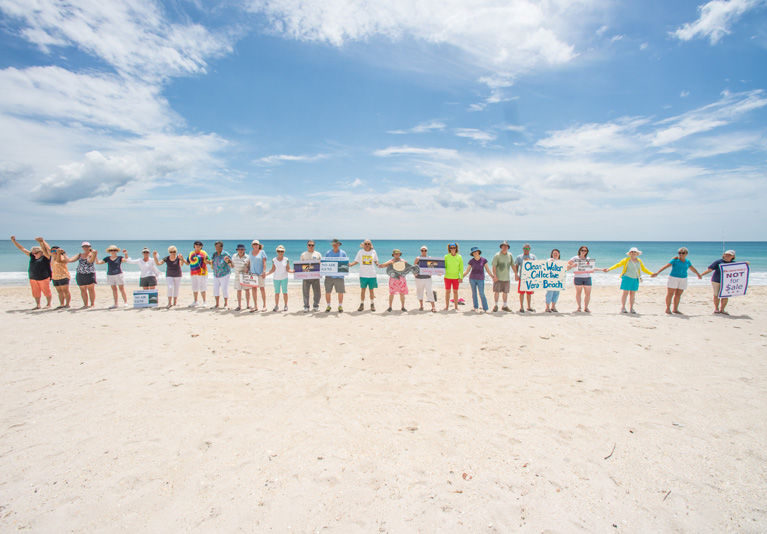
A group of concerned environmentalists gathered at the Tracking Station Beach Park at Noon Saturday for Hands Across the Sand, joining thousands of others around the country to symbolically draw a line in the sand to promote clean renewable energy sources for a sustainable planet. The group also hoped to raise awareness of the Atlantic Seismic Airgun Protection (ASAP) Act, to protect marine mammals, sea turtles, fish and wildlife with a moratorium on oil and gas exploration along the coast.
Dave Rauschkolb founded the Hands Across the Sand movement in October 2009 after the Florida House of Representatives passed a bill to lift a ban on near-shore drilling. The bill was tabled in early 2010 after more the 10,000 Floridians joined hands in united opposition, just two months before the devastating BP Deepwater Horizon explosion in the Gulf of Mexico.
“We learned from the Deepwater Horizon disaster that there is no such thing as cleaning up an oil spill. Two weeks ago there was another 900,000-gallon spill in the Gulf again,” said organizer Debra Messer, Indian River Democratic Party environmental chair, who is leading the local effort to end the country’s dependence on potentially destructive fossil fuels.
“This is our home; it affects us,” said Messer. “We can make a difference. We can.”
As folks began to gather, Justin McSweeny, of Oasis Organics, led early arrivers on an interpretive nature walk, pointing out native and invasive plants on the dunes, including the quite pretty “sea burger” seeds that drift in with the tide from Central America.
Following the beachside joining of hands, many took advantage of the offer to tour the Florida Institute of Technology’s Vero Beach Marine Laboratory adjacent to the park. Research Associate and Site Manager Nancy Pham Ho provided a fascinating behind-the-scenes visit of the facility where the mission is “to develop new strategies for responsible aquaculture and educate the community about aquatic organisms through research demonstrations and hands-on learning programs.”
Scientists at the four-acre satellite campus focus on the research and production of sustainable resources, including single-celled algae, shrimp, seahorses, aquarium fish and food fish, in a responsible manner to reduce their being harvested in the wild. Their teams also collaborate with numerous nonprofits and private firms such as Spirulina Ice, which rents space to produce its nutritious, high-protein algae.
Ho explained that the amazing little seahorses – after an elaborate courtship, the male eventually gives birth by expelling the babies from his stomach – are one step away from endangered status, primarily due to overharvesting, especially in Asia where they are thought to have medicinal purposes. FIT researchers are working with others on a Species Survival Plan Program to improve their numbers in the wild.
The three native Florida seahorse species – lined, longsnout and dwarf – are all found in the Indian River Lagoon amongst the threatened seagrass beds, yet another reason for concern. Their research has shown that the species can hybridize, so they are currently collecting and researching seahorse DNA to determine how populations along the coast might be related.



